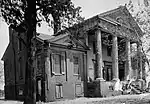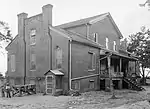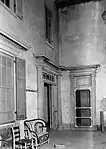Goode–Hall House | |
 The house in 2006 | |
  | |
| Nearest city | Town Creek, Alabama |
|---|---|
| Coordinates | 34°43′31″N 87°23′24″W / 34.72528°N 87.39000°W |
| Built | 1824 |
| Architect | Saunders, Rev. Turner |
| Architectural style | Jeffersonian |
| NRHP reference No. | 74000418[1] |
| Added to NRHP | October 01, 1974 |
The Goode–Hall House, also commonly known as Saunders Hall, is a historic plantation house in the Tennessee River Valley near Town Creek, Alabama. It was added to the National Register of Historic Places on October 1, 1974, due to its architectural significance.[1]
History
The house was built in 1824 by Turner Saunders, a Methodist minister and planter originally from Brunswick County, Virginia.[2] After living in the house for a little more than a decade, Saunders sold it in 1844 to Freeman Goode.[2] The house was later acquired by the Hall family and then, in the 1940s, it passed into the care of the Mauldin family when they purchased the 1,000-acre (400 ha) farm property that the house sits on. It remains in the Mauldin family today, although they have never resided there because of its remote nature.[3]
Architecture
The house is built in a provincial interpretation of a Palladian three-part plan, possibly influenced by the Jeffersonian architecture of Saunders' native Virginia.[2][4] The cramped proximity of the three front triangular pediments betray the vernacular nature of the composition, although the remainder is well-proportioned.[3]
The entire house is constructed in brick above a raised basement. The two-story main block features a Tuscan portico with an arched lunette in the pediment, this feature was a common Jeffersonian architectural device. The main block is flanked to either side by one-story wings with front and side gables, their front pediments also have lunettes. The front walls of the wings feature brick pilasters with simple capitals.[2] The front door is noteworthy in that it features two engaged Tuscan columns supporting a molded cornice.[3]
The Goode–Hall House was not the only large plantation house built in the area by the Saunders family. Turner Saunder's son, James, built a large Italianate house at Rocky Hill Castle.[5]
 Front (south) and west elevation in 1937.
Front (south) and west elevation in 1937. Rear (north) and east elevation in 1935.
Rear (north) and east elevation in 1935. Front porch, detail of front entrance.
Front porch, detail of front entrance.
See also
References
- 1 2 "National Register Information System". National Register of Historic Places. National Park Service. April 15, 2008.
- 1 2 3 4 Gamble, Robert (1990). Historic architecture in Alabama: a guide to styles and types, 1810-1930. Tuscaloosa, Alabama: The University of Alabama Press. pp. 10, 53–55. ISBN 0-8173-1134-3.
- 1 2 3 Cooper, Chip; Harry J. Knopke; Robert S. Gamble (1993). Silent in the Land. Tuscaloosa, Alabama: CKM Press. pp. 126, 188. ISBN 0-9636713-0-8.
- ↑ "Plantation Architecture in Alabama". Encyclopedia of Alabama. Archived from the original on 2011-07-26. Retrieved 2008-12-12.
- ↑ Gentry, Dorothy (1962). Life and Legend of Lawrence County. Tuscaloosa, Alabama: Nottingham-SWS, Inc. pp. 109–110.